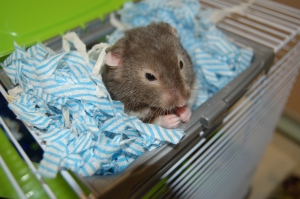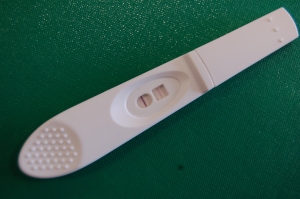The briefest of burbles this week as we’re setting up the Year 12 Practical Skills Assessments – 38 students – and it’s all a bit manic.
So, pregnancy testing kits. Even I would not ask for a student volunteer to donate urine to show how they work – finding out that you’re pregnant, whether it’s a moment of life-affirming joy, or an unmitigated disaster, is not something that should happen in a Biology lesson. Mind you, I would have no problem asking a volunteer to use a fertility testing kit – and several brave girls over the years have done so.
I did test the urine of the class female hamster (Hettie)
with a pregnancy testing kit, as she had recently mated with the male (Herbie)
and we had high hopes of baby hamsters. The test came up negative but, which turned out to be correct, but we still don’t know if HCG (Hamster Chorionic Gonadrotrophin) is sufficiently similar to HCG (Human Chorionic Gonadotrophin) for the test to work if she was pregnant. Maybe in the summer term when Hettie and Herbie will meet again…
Anyway, pregnancy testing is on the OCR A2 spec. How to teach it? Specifically, how to teach it so that they learn how it works, rather than telling them how it works so that they then have to go away and learn it?
I started by showing them the positive test for George, our youngest son. There he is, bless him, George’s first communication with the outside world, a little message saying, “I’m here! Look after me!” I still look on this as faintly miraculous. I give them a little bit of human detail – we had hoped for a girl, 3rd time round, but on the 20 week scan, along with the bones and kidneys and brain ventricles and beating heart, there was another structure visible that could only mean one thing, another bloody boy… A few tears in the carpark afterwards… but once George had actually manifested himself as George, we obviously wouldn’t change a thing.
But how does the actual test work?
I set it as a kind of Dragons Den/The Apprentice/Young Enterprise exercise. I asked them to imagine they were the development team at GSK and you’d come up with a brilliant idea to invent a pregnancy testing kit. Make millions from grateful women the world over! And then told them to invent it. From scratch. No research allowed.
It was joyous. They quickly decided that they needed to look at it from the consumer’s point of view as well as the biological point of view. What would the customer want? Has to be reliable and easy to use. So urine rather than blood. Something in the urine that is uniquely associated with being pregnant. That means it’s also got to be small enough to get through the basement membrane (i.e. molecular mass < 69,000 in the kidney.
At this point I provided a bit of scaffolding – the molecule you’re looking for is HCG. Released by the embryo very early on in pregnancy to prevent the yellow body breaking down and maintain the supply of progesterone. I love this – the idea that your baby is chemically manipulating you right from the start.
They quickly come up with the idea of some kind of receptors. They’ve picked up on my much repeated assertion that if you can do jigsaws, you can do Biology. But somehow they’ve got to colour code the receptor. And they’ve got to arrange things so that there’s a control line as well as the positive/negative line. Someone finally hits on antibodies, and I scaffold some more, telling them that specific antibodies can be manufactured in sheep, and that antibodies can be tagged at the end of the constant region with the colour of their choice. Much amusement when someone imagines centrifuging a sheep (rather than the sheep’s plasma).
They keep going. They hit on the principle of capillary action. Perhaps the antibodies could move along a fabric or something? But then they need to be stopped. But only if they’re bound to HCG. Er, this is getting complicated. But they sketch it out, and I provide a bit more help, and they’re there. Pretty much. So when we finally draw out the diagram and sketch a positive/negative test, and answer some interpretive questions, they already know and understand it. pregnancy tests
It was a fabulous example of co-operative learning – it wasn’t a particularly bright group, but they trusted my implicit assertion that, yes, you can do this, and they worked together, every student making suggestions and thinking aloud. None of them could have done it on their own. As a group, they did.
They were thrilled at their own cleverness, and fascinated by the cleverness of the testing kit. And to add to my own happiness at a lesson that had worked so well, SLT had popped in to observe it as part of one of their Learning Walks.
Back to the PSAs! Have a good week.


